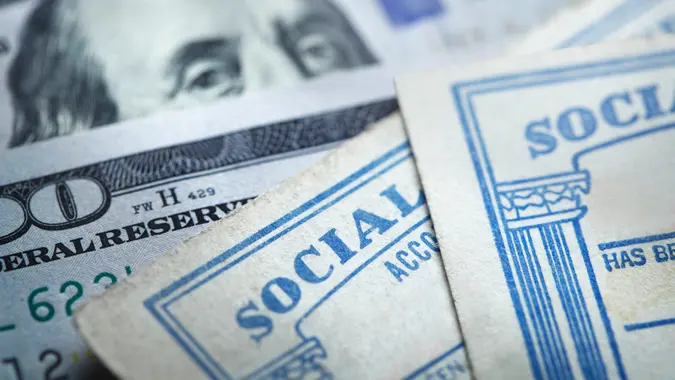Social Security 2023: 4 Groups of People Who Should Not Rely on Social Security Alone

Commitment to Our Readers
GOBankingRates' editorial team is committed to bringing you unbiased reviews and information. We use data-driven methodologies to evaluate financial products and services - our reviews and ratings are not influenced by advertisers. You can read more about our editorial guidelines and our products and services review methodology.

20 Years
Helping You Live Richer

Reviewed
by Experts

Trusted by
Millions of Readers
Social Security is a major source of retirement income for many seniors in the United States, but not all of them. About 3.5% of the U.S. population ages 60 and older never receive Social Security benefits, according to the Social Security Administration. Even a large population of seniors who do qualify for Social Security retirement benefits can’t rely on those payments alone to pay the bills.
This is mainly because Social Security checks don’t go very far in today’s economy. The average Social Security payment for retired workers is $1,825 a month, according to the SSA. That’s well below the median monthly income of $4,400 for private-sector workers, based on the latest U.S. Bureau of Labor Statistics data.
For someone who worked all their adult life at average earnings and retired at age 65 in 2022, Social Security benefits replaced only about 37% of past earnings, according to the Center on Budget and Policy Priorities. Social Security’s “replacement rate” began to decline as the program’s full retirement age gradually rose from 65 years old in 2000 to 67 in 2022.
The average Social Security check won’t go very far in terms of paying the bills. A recent report from Rent.com found that the median national rent alone is $1,995 a month. As recently as 2021 — before last year’s soaring inflation rate kicked in — average monthly expenditures for U.S. households were $5,577, according to the latest BLS data. For individuals, average expenditures came to about $3,400 a month, according to data from the St. Louis Fed.
For Americans whose Social Security check is well below average, it’s all but impossible to rely on Social Security income alone in retirement. Here’s a look at four groups of people who shouldn’t rely solely on Social Security.
Infrequent Workers
Social Security retirement benefits don’t magically appear when you reach the age to claim them — 62 is the earliest you can do so. You only qualify for benefits if you work long enough and pay enough into the system through payroll taxes. You must earn at least 40 Social Security credits to qualify for benefits, according to the SSA. Credits are only earned when you work and pay Social Security taxes.
You can earn up to a maximum of four credits per year. The amount of earnings it takes to earn a credit can change each year. In 2023, you earn one Social Security and Medicare credit for every $1,640 in covered earnings each year. You must earn $6,560 to get the maximum four credits for the year. Seniors who spent much of their adult lives not working will find themselves with little or no Social Security income.
Late-Arriving Immigrants
Similar to infrequent workers, immigrants to the United States who arrive too late to build up a sufficient work record might not qualify for Social Security benefits at all.
Public-Service Pensioners
As GOBankingRates previously reported, a pair of decades-old provisions have restricted Social Security benefits for public-sector pensioners. Those provisions are the Windfall Elimination Provision (WEP) and Government Pension Offset (GPO), which were enacted in 1983 and 1977, respectively.
Because of the WEP and GPO, many state and local government jobs aren’t covered by Social Security. The reason is that these workers don’t pay Social Security taxes on their earnings or get credit for that work when the SSA calculates their benefits. Instead, they are given pensions designed to replace Social Security.
Self-Employed Workers Who Don’t Pay Enough Taxes
If you own a business, work as an independent contractor, freelance for a living or get by solely on side hustles, you’re supposed to pay income taxes — including Social Security taxes. This is typically done through quarterly estimated tax payments. If your net earnings are $400 or more in a year, you must report your earnings on Schedule SE in addition to other tax forms you must file, according to the SSA.
As of 2023, self-employed workers must put 12.4% of their earnings into Social Security taxes. That is the total amount that employees (6.2%) and employers (6.2%) combined must contribute. If you underpay or fail to pay these taxes, you not only face IRS penalties — you also will find yourself with little or no Social Security retirement benefits.
 Written by
Written by  Edited by
Edited by 
























